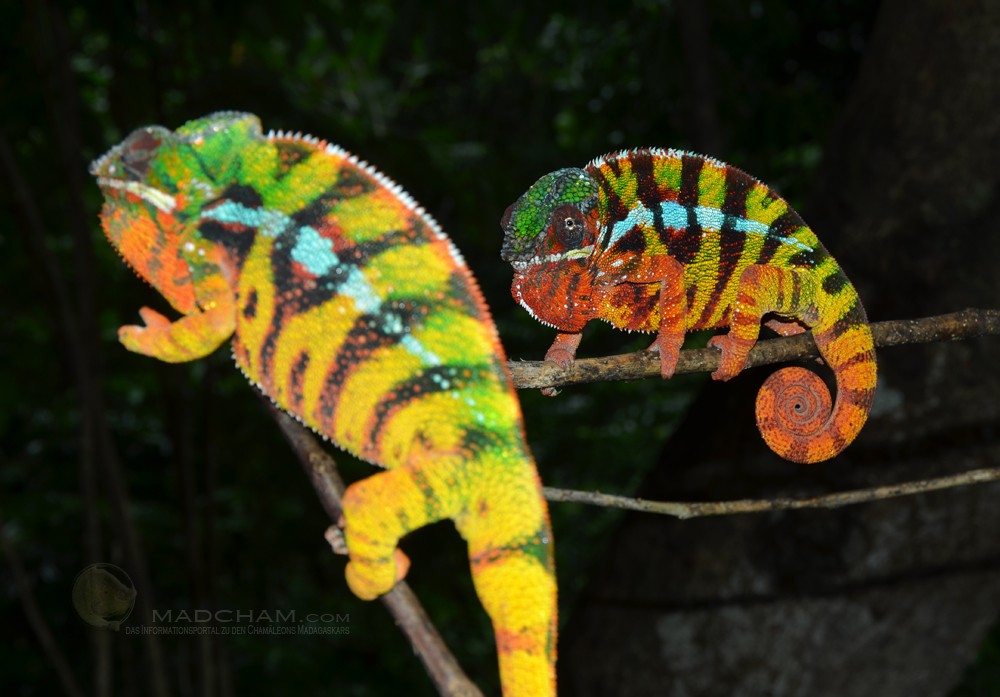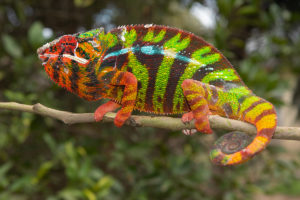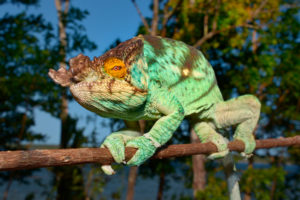Chameleons among each other
Most chameleons, e.g. Furcifer pardalis, can only be kept individually, as they are very aggressive within the species. Pairings are often only possible for the duration of the pairing itself. The chameleons do not necessarily have to bite or attack each other, only the presence of a second animal can lead to death due to the stress caused in the oppressed animal. Young animals can often still be reared in groups, but already at the age of a few months, the chameleons have to be accommodated individually.
In some African chameleon species, it may be possible to keep couples or groups with ample space. In such cases, alternative terrariums should always be provided, because not every individual gets along with partner animals. Also, some pair-holds of Calumma parsonii are known. Such groups should be kept exclusively by experienced owners, who know the individuals for years and notice also small signs of incompatibilities. In pairs that have been kept together from a young age on, it may happen that males do not want to mate or females become gravid much too early. In case of doubt, keeping chameleons solitary is always a safe option.
Housing chameleons together with other reptiles
Chameleon owners (especially beginners) often want to keep other species in the same terrarium. This seems to save space, technology (and money) and the animals can interact with each other instead of sitting around bored… or is it not that easy?
In principle, the following considerations should be made:
- The species to be socialized should come from the same habitat and occur in parallel in nature. In addition, they should require the same climatic conditions and very similar terrarium equipment. A horn frog, for example, needs different conditions than a chameleon and comes from South America, where there are no chameleons at all.
- One species should not be the prey or predator of the others. Big chameleons try to shoot at almost anything that moves fast. Small geckos, anoles, frogs, small mammals or birds in the same terrarium/room are therefore welcome food. Be careful even with larger geckos like Phelsuma grandis – attacks from chameleons are also known for this species. On the other hand, larger lizards can easily eat small chameleons.
- The animals should not disturb each other. A nocturnal, large gecko species, for example, can massively disturb a sleeping chameleon and vice versa during the day.
- Normal terrarium sizes are not sufficient. There must be a very generous, well-structured terrarium that offers more than enough space for both species.
- Alternative terrariums must be available for all animals placed in a foreign cage. This means that for each animal there must also be an unoccupied but fully equipped terrarium. So you don’t save anything in technology, space, and money.
- The owner should be able to care for both types separately from each other for years successfully, and know the individual animals and their behavior. Simply putting newly bought animals together carries a high risk of conflict. In addition, especially beginners in chameleon keeping should first learn to correctly interpret the animals and their often easily overlooked signs of illness, mood, etc. Not carrying out quarantine can also mean clearing out the entire terrarium in the event of parasite infestation.
- The keeper must have time to observe the animals intensively, in particular during the first weeks, in order to separate individual animals from the others if necessary.
Housing several species together can only function if both species do not have to retreat because of their “neighbors”. As one can see from the conditions mentioned, a permanently functioning socialization of different species requires immense preparations and relatively high expenditure. On the other hand, there is an environmental enrichment of both species and great observations for the owner, but also increased stress and an increased risk of injury for the inhabitants.
Many zoos show terrariums with different species kept together. To conclude from this that the same species could just as well be accommodated together at home can have fatal consequences. Zoos have different conditions than private owners, usually have more resources for short-term accommodation and caregivers with decades of experience. Some zoological institutions show questionable socializations despite better knowledge. Whether and for how long these function, remains hidden from the visitor.
As a general rule, cohabitation should be reserved for very experienced owners and only function in the long term under special conditions. Also always remember: What is good with one holder does not have to be good with the next one. We generally explicitly do not recommend to keep chameleons together with other chameleons or reptiles, but strongly advise against doing so.
















